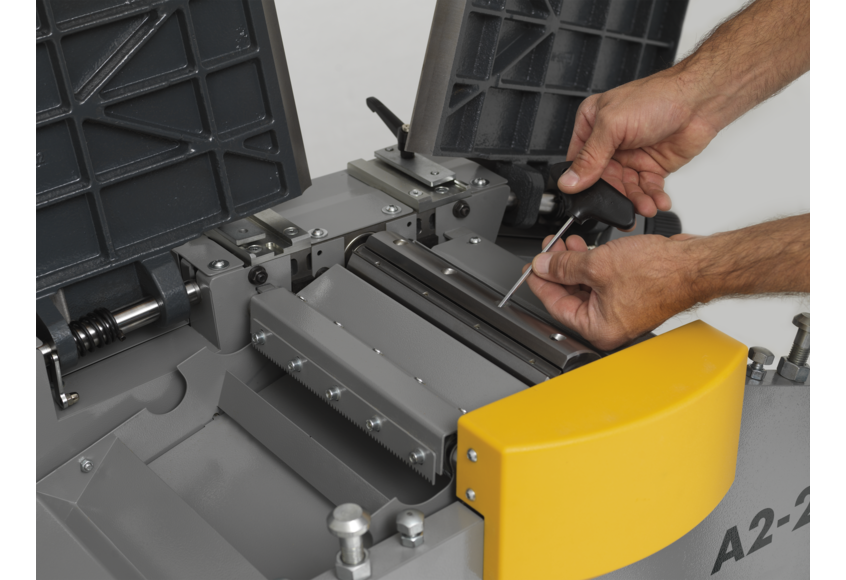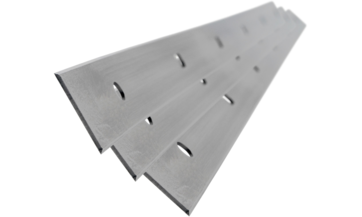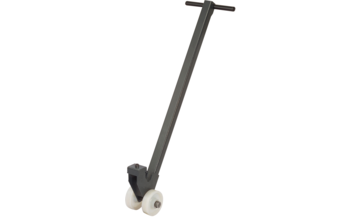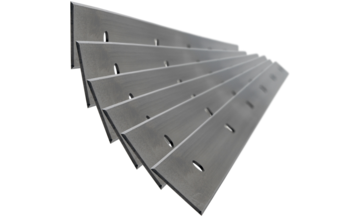Rikt- och planhyvel Hammer A2-26
- Hyvelbredd: 260 mm
- Rikthyvelbord längd 1045 mm
- Hyvelkutter självinställande kutter
- Max. spånavverkning: 3 mm
- Hyvelhöjd 3–184 mm
- Matningshastighet 4,5 m/min
exkl. moms , leveranskostnader tillkommer
inkl. 25% skatt , leveranskostnader tillkommer
Beskrivning
A2 – Den NYA "lilla" rikt- och planhyveln för kvalitet och precision i små verkstäder
Den nya A2-26 övertygar inte bara med bekväma dimensioner för små verkstäder utan också med Hammer-hyvelmaskinstandarder som beprövats i flera decennium.
De massiva hyvelborden i gjutjärn, den enkla hanteringen och den enkla omställningen från rikt- till planhyvling, men framförallt den beprövade Hammer automatiska hyvelkutteraxeln med självjusterande hyvelskär är imponerande detaljer som du inte vill vara utan i din verkstad.
Detaljer
Hammer 3 med snabbväxlande knivar garanterar automatisk inställningsjustering, utmärkt hyvlade träytor och enkel manöverkomfort. Kutterblock systemet har sedan 1987 lyckats hjälpa våra kunder att spara in på dyra investeringar på standard kutterblock. Kutterblocksystemet är endast tillgängligt från Felder Group!

Den starkt räfflade Hammer hyveln och tjockleks tabeller är gjorda av massivt gjutjärn och ger utmärkt precision i varje situation. Bredden för hyvelbordet likställer hyvelbredden, vilket gör att arbetsstycket kan säkert hyvlas igenom hela längden av hyvelbordet.

Spånavverkningen ställs in med ett vred på baksidan av maskinen! Detta garanterar operatören en snabb och exakt inställning av spånavverkningen vid maximal användningskomfort. Maximal spånavverkning är 3 mm.

Lutningen av hyvelanhållet från 90° och 45° sker mycket enkelt genom att lossa de 2 vreden. Dessutom drar operatören nytta av en mycket stor monterad skala. 2 Ändanhåll vid 90° och 45° ger precision, tidsbesparning och användarkomfort.

Platssparande och en ur ergonomisk synvinkel optimal lösning: De bakåt uppfällda riktborden möjliggör inte bara att din Hammer hyvelmaskin kan ställas upp platssparande, utan säkrar också ett ergonomiskt korrekt arbetsförlopp vid planhyvling.

Spånsugshuvens aerodynamiskt optimerade konstruktion ger med ett väl tilltaget spånutrymme ett idealiskt spånutsug och ett rent arbetsbord.

Den maximala planhyvelhöjden är 184 mm. Avläsningen av planhyvelhöjden sker via en stordimensionerad skala på maskinstativet. En ännu mer exakt inställning av planhyvelhöjden, exakt till en tiondels millimeter, sker på begäran med en systemratt och den integrerade digitalklockan.

Tekniska data
| Frekvens [Hz] | 50 |
| Kapacitet (HK) | 2,6 |
| Kapacitet [kW] | 1,9 |
| Längd rikthyvelbord [mm] | 1045 |
| Spänning [V] | 1x 230 |
| Spånavverkning max. [mm] | 3 |
Passande artiklar
HS-M42 Systemhyvelstål
500-07-011 | för Felder / Hammer | Längd 260 mm
Hyvelstål för FELDER, HAMMER och Format 4 systemhyvelstål
fortsätt läsaexkl. moms , leveranskostnader tillkommer
inkl. 25% skatt , leveranskostnader tillkommer
Ratt av aluminium
12.1.311 | Ø 160 mm
Högkvalitativ ratt för vinkeljustering på Felder och Hammer maskiner
fortsätt läsaexkl. moms , leveranskostnader tillkommer
inkl. 25% skatt , leveranskostnader tillkommer
Displayklocka med digital visning
01.1.202 | för hyvelhöjdvisning, borrhöjd Felder FD 250 | Visning i mm
Digital precisionsklocka för montering på systemrattar
fortsätt läsaexkl. moms , leveranskostnader tillkommer
inkl. 25% skatt , leveranskostnader tillkommer
Hjulunderrede för Hammer Serie 3 | utan lyftstång
503-134 | för Hammer A2 26, A3 26, A3 31, A3 41 (från tillverkningsår 09/2011), B3 basic, B3 winner, B3 perform, K3 basic , K3 winner, K3 perform, F3
Hjulunderrede för bekväm transport av Hammer maskiner
fortsätt läsaexkl. moms , leveranskostnader tillkommer
inkl. 25% skatt , leveranskostnader tillkommer
Hävarm för Hammer maskiner
500-149
Hävarm för snabb och enkel omställning av Hammer maskiner
fortsätt läsaexkl. moms , leveranskostnader tillkommer
inkl. 25% skatt , leveranskostnader tillkommer
SS Systemhyvelstål
500-07-010 | för Felder Hammer | Längd 260 mm
Hyvelstål för FELDER, HAMMER och Format 4 systemhyvelstål
fortsätt läsaexkl. moms , leveranskostnader tillkommer
inkl. 25% skatt , leveranskostnader tillkommer
Det här kanske också intresserar dig
Hävarm för Hammer maskiner
500-149
Hävarm för snabb och enkel omställning av Hammer maskiner
fortsätt läsaexkl. moms , leveranskostnader tillkommer
inkl. 25% skatt , leveranskostnader tillkommer
FAQs
Planers are used to produce flat and smooth wood surfaces. There is a distinction between surface planers and thickness planers or the combination of these two machines, the so-called planer-thicknesser. Before a "rough" board of solid wood or plastic can be cut to the desired thickness, the surface planer is used to produce a flat and smooth surface on one side and a flat and smooth surface at a 90-degree angle to it on the narrow side. Subsequently, the facing, unprocessed surface can be planed to the desired thickness with the thicknesser. The result is an entirely smooth and, above all, dimensionally and angularly accurate workpiece - a guarantee for the success of all subsequent machining or application processes.
The frictional resistance between the machine table and the wood is reduced with special lubricants developed for woodworking. Especially when working with resin-rich solid woods, the use of lubricants in woodworking is inevitable. Liquid lubricants are best suited and their application onto the machine table via a spray bottle is very simple and easy. When using lubricants, it is important to ensure that they are fully volatilised after processing to prevent any negative effects on subsequent surface treatments with stains and lacquers. Here you can find Supergleit - the best choice for planing, but also as a lubricant for circular saw and moulding operations.
The purchase price of a planer depends on several factors - the type of machine, planing width, scope of performance and functions, the degree of automation or other desired features. Well thought out from the start, a perhaps higher purchase price pays off in the long run compared to a purely price-based purchase. Additional costs for high technology and work safety, which are incorporated as key components in planers, maintain their value over the years and even decades. One example: the Silent-Power® spiral cutterblock from Felder with spiral blade technology is many times quieter than other cutterblocks, protecting your ears and increasing work safety. The Silent-Power® spiral cutterblock also uses carbide reversible blades with 4-fold cutting edges - which increases the tool life by up to 20 times compared to HSS or SS cutting materials. The Silent-Power® spiral cutterblock therefore scores across the board and saves you money at the same time. Scroll up for a wide selection of planer/thicknessers in every price and performance range.
In many European countries, regulations require the sole use of clean-air extraction units in commercial establishments. Clean-air dust extractors reduce the dust load in the ambient air to 0.1 mg/m3 residual dust content. Of course, from the point of view of work safety and health, clean-air dust extractors are always a good choice - even beyond legal regulations. When choosing an air filter dust extractor, the dust load of the air in the workshop can also be reduced with so-called cartridge filters. The following applies to both clean-air and air filter dust extractors: The air speed at the machine-side extraction connection must be between 18 m/s and 22 m/s; 28 m/s for the continuous processing of predominantly wet wood. Extraction capacity calculations, which calculate both the cross-section of the necessary pipes or hoses and the required power of the extraction unit or system on the basis of the number of machines and the distance to be extracted, provide one hundred percent certainty for perfect extraction results. Of course, when extracting dust from a planer, the width of the cutterblock and the maximum possible chip removal must also be taken into account. These two values determine the expected volume of chips removed through the dust extraction hose or pipe system via the dust extractor system or unit. If the chip bags or containers are too small, the cycles for emptying them will increase considerably. Here you can discover our large selection of dust extractors and filters.
Stationary planer-thicknessers are used for flush planing and levelling of solid wood. As a first step, the wood is planed. The workpiece is fed to the rotating cutterhead through the infeed surface planer table. The alignment of the infeed planer table is parallel to that of the cutting circle of the cutterblock. This distance between the planer table and the cutting circle is responsible for the chip removal and is usually adjustable; depending on the design, the chip removal can vary by up to several millimetres. After feeding the workpiece to the cutterblock and after chip removal, the workpiece passes over the outfeed planer table. The outfeed planer table and the cutting circle of the cutterblock are in parallel alignment, i.e. the cutterblock and the outfeed planer table are at the same level. The result is an aligned, flat and smooth wood surface. This process is called "planing", the corresponding machine is called "surface planer". The side opposite to the planed wood surface can now be planed to the desired thickness in a second work step. This operation is called "thicknessing" and the machine required for this is the "thicknesser". Thicknessers have a thicknessing table that can be adjusted to size in height. A feed roller, usually grooved or toothed, located in front of the cutterblock ensures that the workpiece is fed safely to the cutterblock. The cutting circle of the cutterblock corresponds to the set thicknessing table position, the chip removal rate possible in each case can be up to several millimetres. Behind the cutterblock is a smooth outfeed roller that gently transports the thickness-planed workpiece away from the cutterblock. Depending on the application, surface planers are used as stand-alone machines or as combined surface and thickness planers. Here you can see the chip flight during planing work in super slow motion.
Generally, the main criteria for buying a planer is the intended area of use, a defined amount of space, ease of use and sustainability in terms of the cost of planer knives. A quick commercial answer is the intended area of use, planing, thicknessing or both in one, with a defined amount of use per day, per month or per year. The higher the expected workload, the higher the quality and stability required of a new planer/thicknesser. In terms of space, the mere machine footprint should not be considered the sole criterion; some planers require additional, valuable floor space due to their design - e.g. for protruding fences behind the machine. In any case, a very good alternative where space is limited are planer-thicknessers. Ease of operation comprises decision criteria such as set-up and changeover times, the latter especially in the case of planer-thicknessers. While the adjustment of planing or thicknessing tables is mainly done manually on smaller planers, electrical adjustment options with LED displays up to programmable positioning and roughing finishing allowances are mostly standard on larger planer-thicknessers. For decades, various manufacturers have been producing flawless, sustainable sets of planing knives using reversible knife technologies. Nevertheless, there are groundbreaking developments that are becoming more and more popular on the market, such as the Silent-Power® sprial cutterblock from Felder that reduces noise by half, equipped with carbide reversible cutting edges and 4 cutting chamfers per cutting edge. The tool life of carbide is 20 times higher than that of HSS or SS cutting materials. The Silent-Power spiral cutterblock therefore scores across the board and saves you money at the same time. You can find a wide selection of high-quality planer/thicknessers for many applications further up on this page.

























